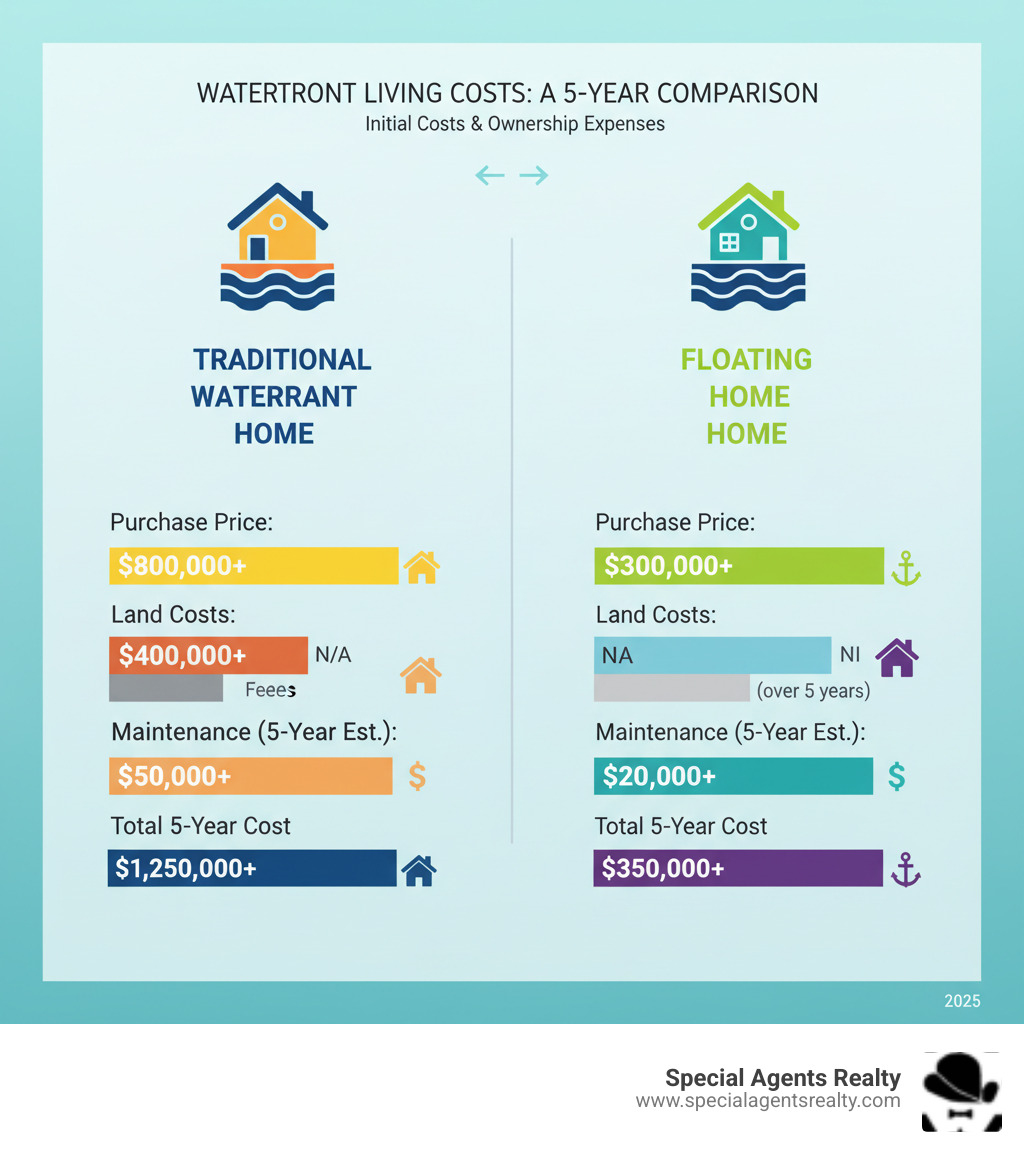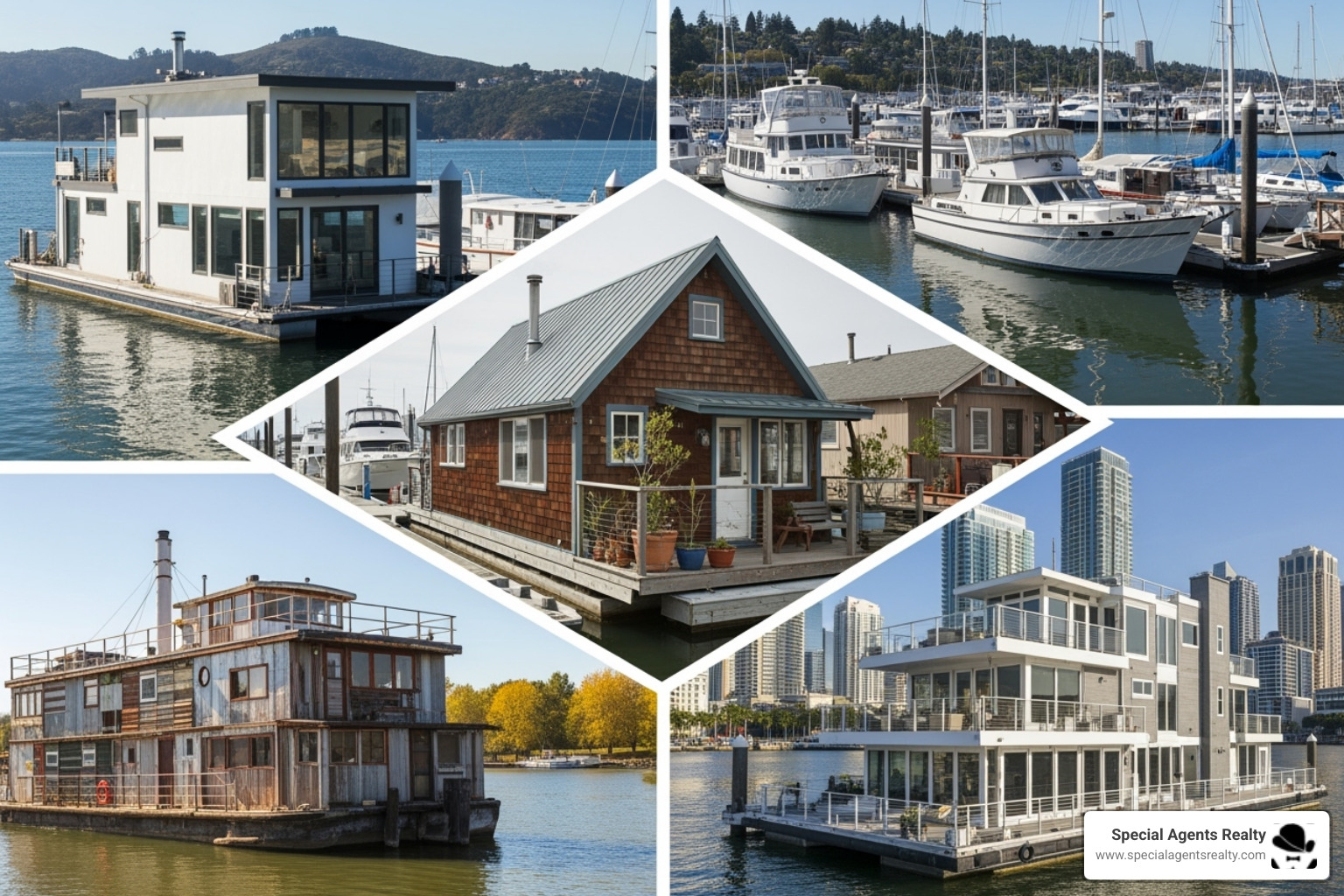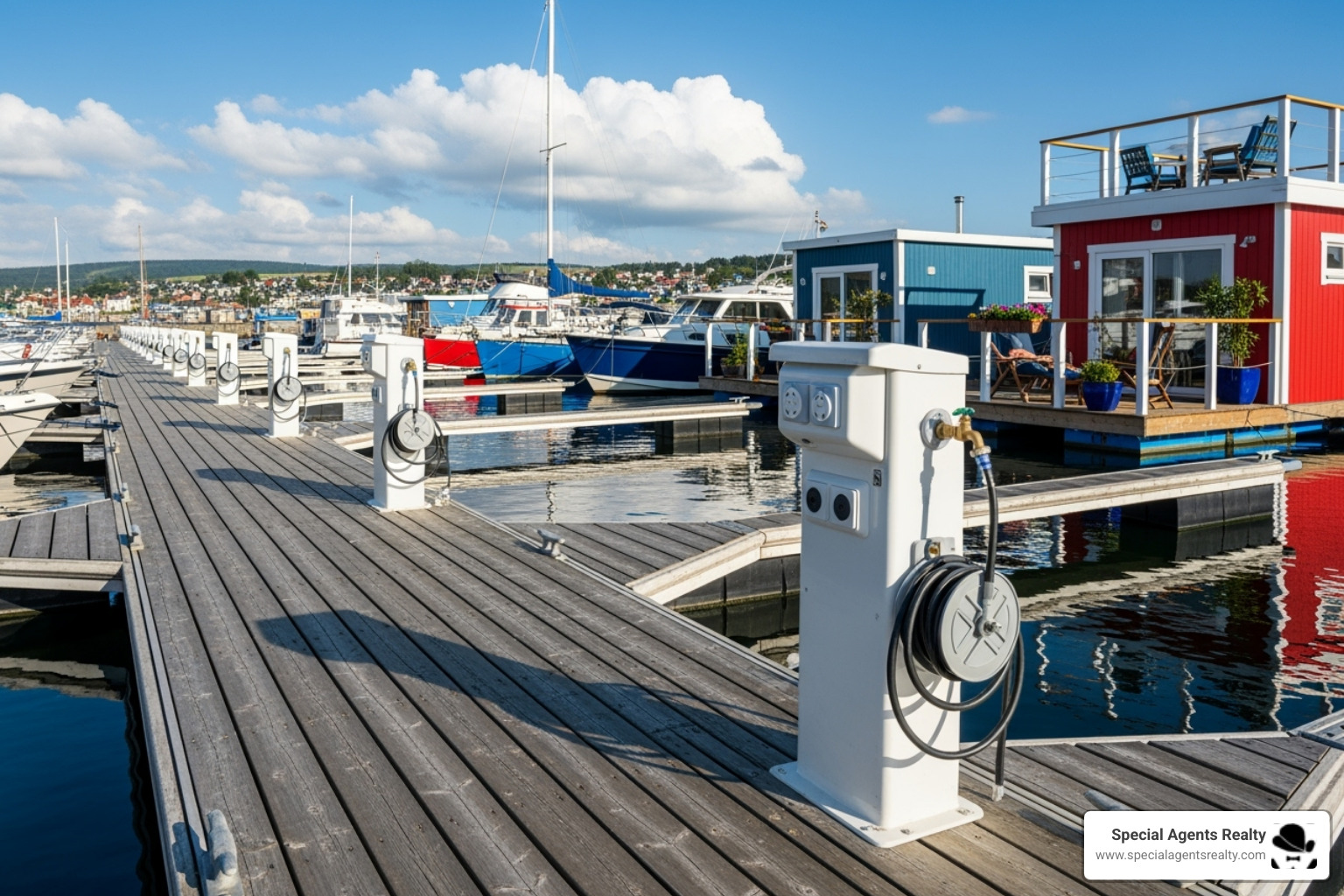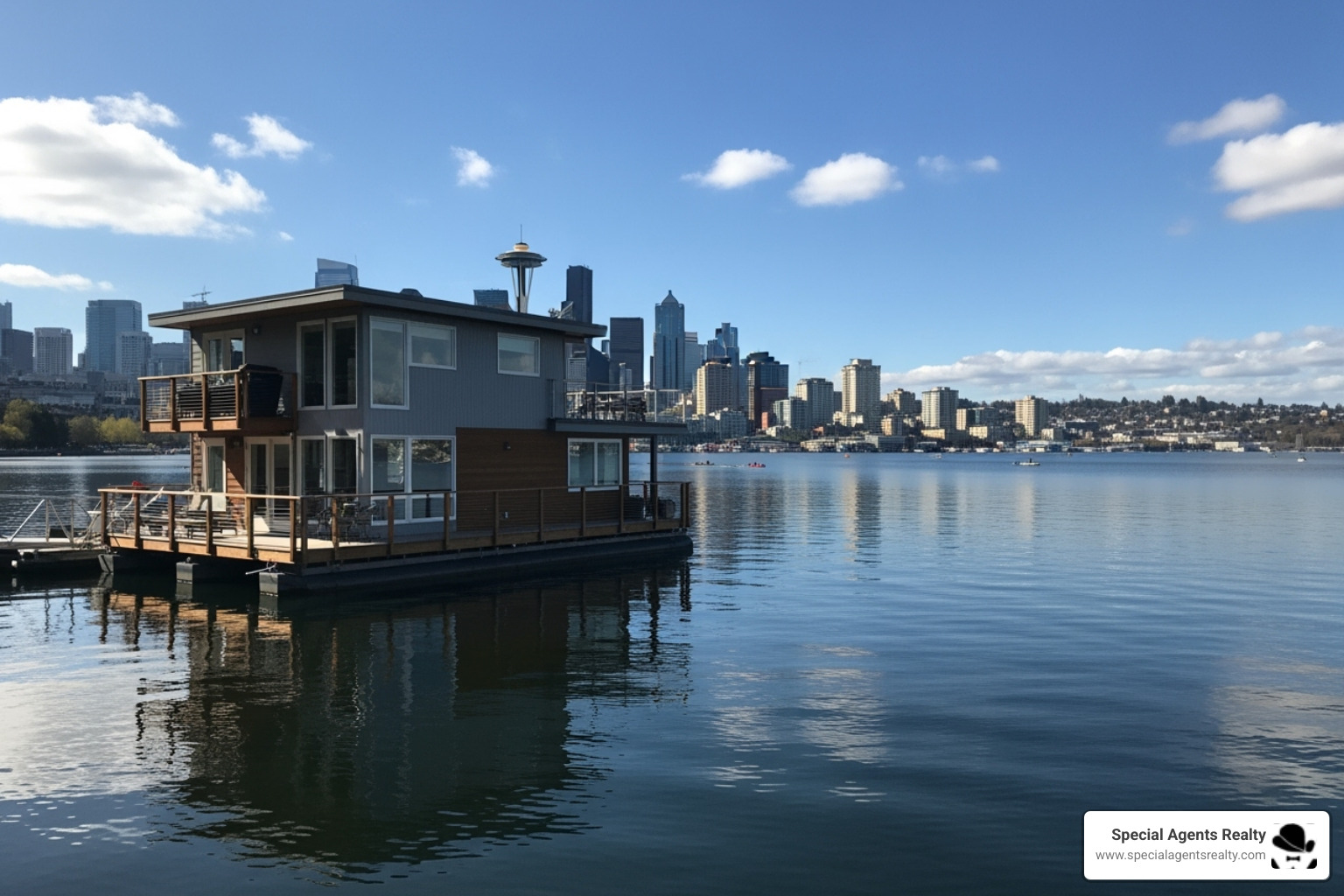
Why Affordable Floating Homes Are Capturing Attention
Affordable floating homes are emerging as a unique solution in a challenging real estate market. While traditional waterfront properties command premium prices, floating homes offer an alternative path to waterside living—but "affordable" is a relative term that requires careful examination.
Quick Answer: What Makes Floating Homes Affordable?
- Price Range: Floating homes span from $6,290 to over $1.4 million, with many options between $200,000-$700,000
- Key Affordability Factors: No land purchase required, smaller square footage, prefabricated construction, and older or simpler designs
- Hidden Costs to Consider: Monthly mooring fees ($400-$1,500+), specialized maintenance, hull inspections, and insurance
- Location Matters: Established communities like Seattle's Lake Union, Portland's marinas, and Sausalito offer varying price points
- Financing Challenges: Traditional mortgages often don't apply; boat loans or specialized marine lenders are typically required
The lifestyle—waking up to water views and enjoying activities like kayaking right from your deck—is a major draw for residents in communities from Amsterdam to Seattle.
However, while some floating homes cost less than traditional properties, the total cost of ownership extends far beyond the purchase price. Monthly mooring fees, specialized maintenance, insurance, and regulatory problems all impact the true affordability equation.
From the 400+ homes in Sausalito to the 2,500 in Amsterdam, this housing market is diverse. In Seattle's Lake Union, post-WWII affordable housing has evolved into a mix of modest dwellings and luxury investments. Nationwide, hundreds of houseboats are for sale, with prices varying widely by age, condition, and amenities.
Understanding what makes a floating home truly affordable requires looking beyond the sticker price to examine construction, ongoing expenses, local regulations, and long-term maintenance.

What Makes a Floating Home "Affordable"?
When comparing affordable floating homes to traditional waterfront real estate, the price difference can be staggering. Understanding the factors behind this helps separate genuine value from hidden expenses.
The most significant affordability factor is that you don't buy land. A floating home purchase is for the structure itself, eliminating the most expensive component of waterfront living.
- Size: A compact 400-square-foot home costs far less than an 800-square-foot model due to lower material costs and smaller moorage needs.
- Construction: Prefabricated floating homes built in factories are significantly cheaper than custom builds, thanks to streamlined production and reduced labor.
- Materials: Affordable options use durable, practical materials, while high-end homes feature luxury finishes like exotic hardwoods and marble.
- Age and Condition: An older model requiring renovation will cost dramatically less than a new one. Fixer-uppers, some starting as low as $6,290, can offer exceptional value for those willing to invest sweat equity.
For a deeper dive into what distinguishes different types of floating dwellings, explore our article on Houseboats Floating Homes.
The Benefits of a Lower Price Point
Beyond the purchase price, affordable floating homes offer unique benefits.
The lower initial investment opens waterfront living to a wider audience. With many homes starting between $100,000 and $200,000, the dream of waterside living becomes more achievable.
The unique lifestyle is a major draw. Waking to gentle water movement and panoramic views is an experience that changes your daily interaction with your surroundings.
Proximity to nature is built-in. Wildlife visits are common, and activities like kayaking or paddleboarding are as simple as stepping out your door.
Community bonds in floating home neighborhoods are often tight-knit. Places like Seattle's Lake Union and Sausalito's docks are known for supportive residents who share an unconventional lifestyle.
Many modern affordable floating homes also have a smaller environmental footprint, with compact spaces requiring less energy and designs often incorporating sustainable materials and solar panels.
If you're considering the Pacific Northwest, our team at Special Agents Realty has gathered essential insights in our Tips to Buy a Waterfront House in Seattle.
Potential Drawbacks and Hidden Costs
The "affordable" label requires examining costs beyond the purchase price.
Mooring fees are like rent for your water space and are unavoidable. These monthly fees range from $400 to over $1,500, depending on location and amenities, and cover docking, water, garbage, and sewage.
Specialized maintenance is crucial. A floating home's hull requires regular professional inspections and cleaning. Water and sewage systems also need specialized care that differs from a traditional home.
Hull inspections are a critical and expensive periodic assessment. They often require hauling the home out of the water, a complex but necessary operation to ensure structural integrity.
Navigating regulations can be complex. Zoning laws, environmental rules, and marina-specific policies vary dramatically. Seattle, for instance, has different rules for "Floating On Water Residences" (FOWRs) and houseboats.
Financing challenges are common. Traditional mortgages don't apply because there's no land. Buyers typically need specialized boat loans, which may have higher interest rates and shorter terms, or they must pay cash.
Before diving in, arm yourself with knowledge. We've assembled a comprehensive guide: 5 Things To Know When Buying A Houseboat And Floating Home.
Exploring the Types of Affordable Floating Homes
The world of floating homes is diverse, from mobile vessels to permanent residences. Understanding these types is key to finding an affordable floating home that fits your lifestyle and budget.

Houseboat vs. Floating Home Distinction
Though often used interchangeably, these terms have distinct legal and functional meanings.
A houseboat is legally a vessel. It has a motor and can move under its own power. It's subject to maritime regulations and is ideal for those who want mobility. Houseboats on Boat Trader average 64 feet and range from 25 to 104 feet.
A floating home, or FOWR (Floating On Water Residence), is built on a floating foundation without an engine. It's permanently moored to a dock with utility connections, like a land-based home. While it moves with the tide, it is not designed for navigation.
For more details on these distinctions, explore our article on Houseboats.
Traditional Houseboats
Traditional houseboats are a major segment of the affordable floating homes market. They blend maritime adventure with home comfort.
Their key feature is mobility, offering the freedom to explore different waterways. Affordable models typically have basic, functional amenities. The used market is a great place to find value, with prices on Boat Trader ranging from $6,290 for fixer-uppers to over $1.4 million. Older houseboats are excellent DIY projects for those willing to renovate and customize their space.
Tiny Floats and Modern Designs
Inspired by the tiny house movement, a new wave of affordable floating homes focuses on compact, efficient, and sustainable designs.
"Tiny Floats," like those from Dutch architect Waterstudio.NL, are compact structures (under 484 sq. ft.) perfect for a minimalist lifestyle. These modern designs use clever storage and multi-functional furniture to maximize comfort in a small footprint. They often feature sleek aesthetics with large windows to connect with the water environment. Sustainability is a key feature, with many designs from companies like Waterpod and ECO Houseboats incorporating solar panels, high insulation, and recycled materials. Our own Eco-friendly options like the Eco Sea Cottage illustrate this trend.
Converted Barges
Converted barges are a unique and intriguing option for affordable floating homes. These former industrial vessels offer vast interior spaces and a blank canvas for creative renovation. They retain a distinctive industrial character and are built on an incredibly durable and stable platform. While the initial purchase can be affordable, buyers should be prepared for an extensive conversion project. This route offers significant cost savings for those with construction skills or a clear vision. For an example, see our information on a Seattle Houseboat Barge Captains Quarters.
Decoding the Full Cost of Floating Home Ownership
Seeing a floating home listed for $199,000 is tempting, but true affordability means looking beyond the initial price to understand the total cost of ownership. The purchase price is just the beginning of your financial journey on the water.

The Upfront Price for affordable floating homes
Prices for affordable floating homes vary widely. Boat Trader shows older houseboats starting around $6,290, while luxury models can exceed $1.4 million. The middle ground is where most buyers land. For example, a Portland floating home recently listed for $199,000. In Europe, Tiny Floats start around €95,000 (roughly $100,000 USD). In Sausalito, where homes often sell for $600,000-$1.2 million, options can sometimes be found starting around $400,000.
Price is driven by size, age, condition, construction quality, and location. A small, older fixer-upper will cost far less than a large, modern home in a prime Seattle marina. Negotiation is common, especially for homes needing work.
| Type of Floating Home | Estimated Price Range (USD) | Key Affordability Factors |
|---|---|---|
| Used Houseboat | $6,290 - $200,000 | Age, condition, basic amenities, DIY potential |
| Tiny Float | $100,000 - $300,000 | Small footprint, efficient design, modern construction |
| Small Traditional Floating Home (e.g., Portland) | $199,000 - $700,000 | No land cost, established community, typically static |
Financing is different from traditional homes. Standard mortgages don't apply, so buyers often need specialized boat loans or marine financing. For more details, see our guide: Houseboat Lending Now Available.
Our team also has insights on whether these properties are a good long-term financial move: Are Floating Homes A Good Investment.
Ongoing Expenses to Factor In
Ongoing costs can be a surprise if not budgeted for properly.
- Mooring or Slip Fees: This is your biggest recurring expense, essentially rent for your water space. Expect to pay $400 to over $1,500 per month, depending on the marina's location and amenities. In some communities, you may purchase a share of the moorage and pay condo or HOA dues instead.
- Insurance: You'll need specialized marine insurance, which is different from a standard homeowner's policy and covers the unique risks of living on water.
- Utilities and Services: This includes electricity, water, internet, and potentially propane. If not connected to a municipal sewer, you'll also have regular costs for waste tank pump-out services.
- Property Taxes: Floating homes are often taxed as personal property rather than real estate, with rates depending on the home's assessed value and local rules.
- Maintenance: This is a significant, ongoing cost. The hull is your foundation and requires periodic cleaning, anti-fouling paint, and professional inspections, which can be expensive. The exterior and all systems (plumbing, electrical) also need more frequent care due to the marine environment. Budgeting 1-2% of your home's value annually for maintenance is a smart practice.
Understanding all financial details is crucial. We've created a guide to help you plan: Closing And Title Costs.
An affordable floating home can be accessible, but only if you account for the total cost of ownership. Monthly expenses can easily add $800 to $2,000+ to your housing costs.
Key Considerations for Aspiring Floating Homeowners
Starting on the journey to own an affordable floating home is exciting, but it requires careful due diligence. This is about embracing a unique lifestyle and navigating a distinct set of challenges.

Finding the Right Location
Location is paramount, dictating regulations, costs, and lifestyle. Look for established communities zoned for residential use with the necessary infrastructure.
- Established Communities: Key locations include Seattle's Lake Union, Sausalito's five marinas, and Portland's river communities. While some areas like Seattle have become pricey, affordable options can still be found. You can learn more about A look at Seattle's floating home history.
- Marina Amenities and Rules: Each marina has its own rules, amenities, and personality. Find one that aligns with your lifestyle, whether you need pet-friendly policies or gated parking.
- Moorage Ownership vs. Rental: Most affordable options involve renting a slip, which is an ongoing monthly fee. Less common is purchasing your moorage slip (as a co-op or condo), which provides more stability and potential equity.
- Proximity to Services: Consider your commute and access to essentials like grocery stores and healthcare.
Our team can guide you through the nuances of Living In Seattle's Floating Homes.
Navigating Regulations and Red Tape
The regulatory environment is perhaps the most challenging aspect of ownership.
- Zoning and Permitting: Local ordinances dictate where floating homes are allowed. Building or altering a home involves a complex permitting process.
- FOWR vs. Vessel Designation: In Washington State, the Shoreline Management Act distinguishes between "Floating On Water Residences" (FOWRs) and vessels (houseboats). This impacts everything from taxes to financing. The Seattle Shoreline Master Plan Receives Final Approval is an example of how local planning affects liveaboards.
- Environmental Rules: Regulations govern waste disposal and materials like anti-fouling paint to protect water quality.
- Inspections: Regular hull, electrical, and plumbing inspections are required for safety and compliance. We always stress the Importance Of Inspection.
Securing Financing for affordable floating homes
Securing a loan is a common hurdle for buyers.
- Challenges with Traditional Mortgages: Because they don't include land, floating homes typically don't qualify for conventional mortgages. This leads to a high number of cash buyers in many markets.
- Specialized Loans: The most common options are boat loans (for vessels) or loans from specialized marine lenders who understand these unique properties. These loans often have shorter terms and higher interest rates than traditional mortgages.
- Other Options: Some buyers use seller financing or tap into equity from an existing land-based property.
It's essential to work with lenders who understand this niche market. Our team can connect you with resources for Getting A Legitimate Lender And Getting Pre Approved.
Conclusion
The dream of owning an affordable floating home offers a unique blend of waterfront living and community that traditional homes can't match. However, "affordability" is a nuanced concept that extends far beyond the initial purchase price.
While factors like smaller size and the absence of land costs make the upfront price attractive, buyers must be prepared for the hidden costs. Ongoing expenses for mooring, specialized maintenance, marine insurance, and navigating a complex regulatory landscape are all part of the total cost of ownership.
From mobile houseboats to static modern floats, there is a diverse range of options to fit different budgets and preferences in communities like Seattle, Sausalito, and Portland. Successfully securing an affordable floating home requires thorough research and a clear understanding of both the upfront and long-term financial commitments.
If the allure of a floating home has captured your imagination, our team at Special Agents Realty is here to help you steer these unique waters. With our expertise in the Pacific Northwest, we can guide you through the process. Let us help you Find The Best Seattle Floating Homes and make your waterfront living dream a reality.
.avif)






